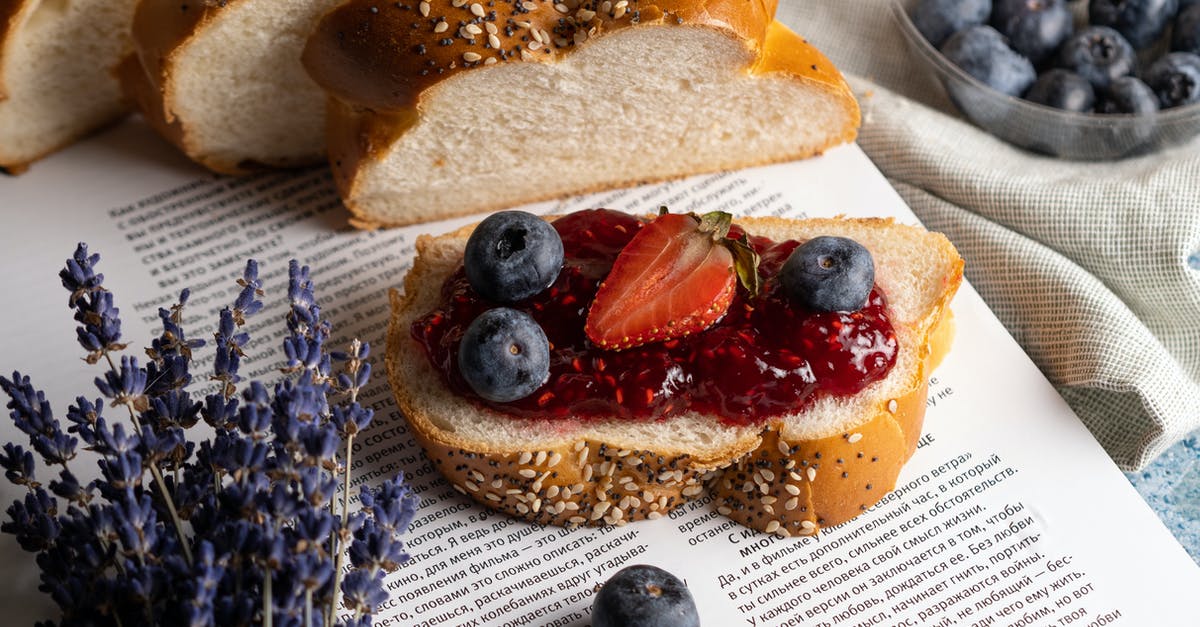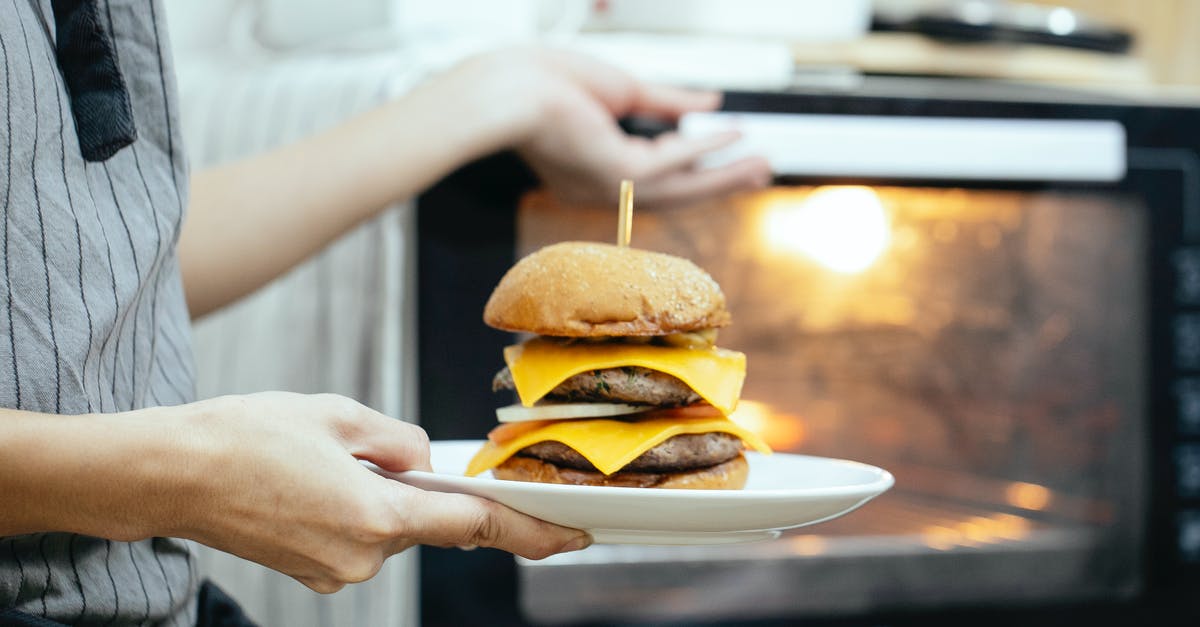What makes a bread either close or open crumbed/textured?

What causes the texture of bread to be open, ie with lots of large holes, or close, ie a regular, uniform tender crumb with no large holes? How can I achieve either?
Best Answer
There are several factors that make bread be "holey". First of all we must understand that those big holes are created by "balloons" of gluten filled with CO2 and alcohol made by yeasts. Those balloons can grow in 2 ways
- Yeast cells close to the balloon make CO2 or alcohol, and it's "poured" into the balloon, and it grows.
- The wall between 2 balloons gets broken, so a new balloon is made with the joining of the former two.
You would also get some bubbles with rye bread and bacteria, but the holes would be smaller. So I'll focus on wheat flour and yeasts.
So, some tips to maximize the size of the holes:
Please, note that those points are not independent. Thanks @rumtscho for pointing it out.
Don't manipulate the dough too much.
Most breads have 2 fermentations:
bulkone andproofing. Do just one. The more you handle the dough, the higher chances to degas it by breaking bubbles and letting the gas get out of the dough.High hydration
With more water the dough will be less stiff, so bubbles will be able to extend more. Also, it will be easier for the yeasts to "find" their food: sugar, so they'll produce more CO2 and alcohol.
Some flours absorb more water than others. Using a flour with high absorption index might allow you
Yeast + time
The more yeasts, the more gas will be made. But be aware not to add too much, or they'll run out of glucose. It's better to give them time to do their work.
Use strong wheat flour
The more time dough is waiting to be risen, the more gluten will be destroyed by enzymes. So using flour with a lot of gluten (strong, high % proteins, a W value over 270) will help assuring a minimum of gluten will still exist after long fermentations.
Oven spring
Yeasts continue producing CO2 until they die at 60C/140F. Also, gasses expand with heat, so it will also help holes to grow a bit (if I remember well, up to 30%). But that grown will stop when dough gets baked and strengthens, and when crust begins to form. To retard this 2 tricks are used:
Use steam in the oven the fist 1/3 or 1/4 of baking time.
Steam will keep the "outer skin" of the bread humid, so it will prevent it from getting dry and forming the crust.
Score the bread
Bread is slashed (those cuts made in its surface) to allow it to grow more easily. So inner bubbles will be able to grow more in the oven.
To allow heat enter in the dough from the bottom to up, bakers use stones in their ovens.
Develop the gluten completely
Kneading is very important, so the gluten network will perfectly developed to retain all the CO2 and alcohol.
To get high hydration doughs, bakers make a normal hydration dough (approx. 66%) with all the flour, and then add the rest of water and knead a bit more to let it absorb it.
An example of a type of bread with big holes can be seen in this Spanish forum (sorry: it's a Spanish bread and I couldn't find it in English).
Ciabattas are also a good example of big holes bread.
Some tips to minimize the holes:
Low hydration
As opposite to high hydration to get big alveolus. As low as 50%
Degas the dough
Some artisan or home bakers press the dough with their hand to avoid having too big bubbles. For certain types of bread, professional bakers use rolls to make a thin one. It's called refinement, and might be made several times (maybe 5 during proofing).
Weak flour.
With less gluten, the bubbles will break letting the gas go out of the dough.
Underproof
Use a short fermentation time so yeasts won't be able to make too much CO2.
Pierce the dough
So any excess of CO2 will leave through the holes, instead of getting kept inside the dough.
Also, to lower the production rate of the yeasts, you can also add a lot (really a lot) of salt, or a lot of sugar, or grease/oil.
As an example, a couple of breads (again in Spanish): Pan Candeal and Bollo Sevillano.
Pictures about "What makes a bread either close or open crumbed/textured?"



Quick Answer about "What makes a bread either close or open crumbed/textured?"
The main factor in the openness of the crumb is hydration. A higher hydration dough will generally have a more open crumb with larger, more uneven holes. A lower hydration dough results in a denser loaf, with smaller holes. As well as hydration, fermentation time also plays a role.What causes open crumb in bread?
An appropriately open crumb is evidence of ample and robust fermentation, sufficient dough strength, and proper dough handling.What creates the texture in bread?
The carbon dioxide gas created by yeast is what gives bread its airy texture, and the alcohol, which burns off during baking, leaves behind an important component of bread's flavor. Second, wheat flour, if mixed with water and kneaded, becomes very elastic.How do you make a closed crumb bread?
If your bread is very compact and the crumb is super tight, it can mean that the hydration level was not enough for amount of flour used. Increasing the water content will help to alleviate this issue. If you're working with higher hydration dough, consider lamination for superior dough strength.125: Three EASY Ways to Transform The Texture of your Homemade Loaf - Bake with Jack
More answers regarding what makes a bread either close or open crumbed/textured?
Answer 2
May I add to the above that fat in a sandwich loaf dough coats the gluten so that longer chains are unable to form -unable to support those large bubbles. Putting a lid on a tin also discourages large pores.
Baguettes are traditionally made of softer (low gluten) flour but developed over a longer period with gentle handling to hold in all that gas.
Answer 3
The main factor in the openness of the crumb is hydration. A higher hydration dough will generally have a more open crumb with larger, more uneven holes. A lower hydration dough results in a denser loaf, with smaller holes.
As well as hydration, fermentation time also plays a role. Usually these go together; a low hydration dough like a normal white sandwich bread usually has a relatively quick fermentation of 2-3 hours, whereas a high hydration dough like a ciabatta or focaccia can ferment overnight or even longer.
ArtisanBakers.com has a good summary here.
Answer 4
There is no short or easy answer to this. In short, the main factors are:
- The right flour and balance between water and flour - depends greatly on flour quality.
- The right kneading.
- The right handling of the wet dough.
- The right baking.
You can read a detailed description of my efforts here (including pictures and videos): http://www.rkursem.com/food/bread/fluffy-bread/
Answer 5
Me thinks some artisan breads with open texture are being made with baking powders, I notice lack of yeast in taste, possibly more liquid, flour with elevated protein content, working dough for tough chewy texture with relatively hard outer crust, perhaps undisturbed extended rise (if some yeast is used, or acidic component to complement levan as many are sourdough), a dry oven, and cooking on stone are all coming into play?
Sources: Stack Exchange - This article follows the attribution requirements of Stack Exchange and is licensed under CC BY-SA 3.0.
Images: Andy Kuzma, Nadin Sh, Ketut Subiyanto, Katerina Holmes
